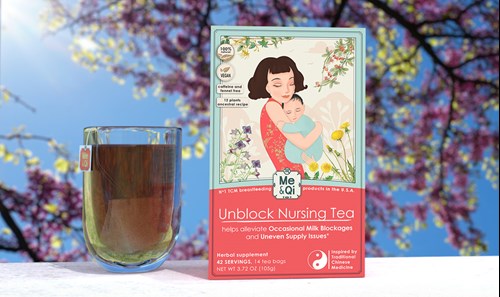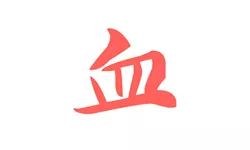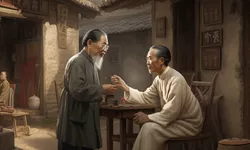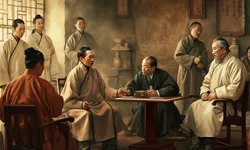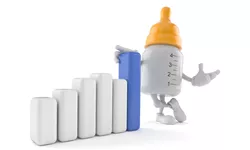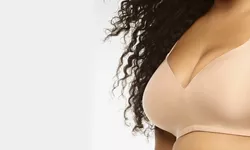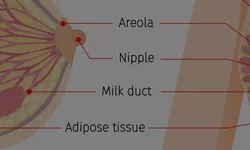What Is A Milk bleb
A milk bleb, also known as a nipple bleb, is a small blister that can cause severe pain during breastfeeding or be completely asymptomatic.
If the bleb does not cause pain, it is advisable to continue breastfeeding as usual without disturbing the bleb. It will disappear on its own eventually.
However, if the milk bleb is painful, it may be tempting to avoid breastfeeding. Nonetheless, frequent breastfeeding is essential for maintaining a healthy milk supply, dislodging the bleb, and preventing clogged ducts, breast engorgement, and mastitis. During this time, a mother can apply pain relieving methods to decrease pain and adopt protective measures to prevent further harm to the area.
Another option is to pop up the milk bleb with a sterilize needle which will be later covered in this article.
How To Prevent The Milk Bleb From Happening
To prevent the occurrence of a milk bleb, there are several steps that can be taken
- Avoid trauma and pressure to the breasts:
It is recommended to avoid any trauma or pressure on the breasts, including avoiding tight-fitting bras or clothes, minimizing breast contact during physical activity, and using proper breastfeeding position and latching.
- Maintain breast hygiene and the right moisture level:
Proper hygiene and moisture levels around the breast area can help prevent the formation of nipple blebs. To achieve this, wipe your breast after every feeding to prevent trapped moisture. You can also use saline or Epsom salt water to clean your breast, but make sure to wipe them afterwards.
Also, remember that after cleansing, if you experience dry or peeling skin on your breast, applying nipple creams can help alleviate these symptoms.
- Consume less heavy food:
According to Traditional Chinese Medicine, overconsumption of heavy foods such as diary, alcohol, red meat, chocolate can lead to the accumulation of Toxic Heat in the breasts, which is root cause of many breastfeeding problems like clogged milk ducts and milk blebs etc.
- Maintain good mental health:
Stress and anxiety can have negative effects on breastfeeding and may contribute to the development of nipple blebs through the development of Toxic Heat. To address this issue, it's important to prioritize good sleep and consider taking naps if necessary. Light physical activity such as yoga, walking, or swimming can also be helpful.
Asking for occasional help from family members with childcare or household tasks can prevent the mother from feeling overwhelmed. This will allow her to have some time for herself to relax, enjoy hobbies, and spend time with friends.
Additionally, it's important to avoid stressful situations or activities that may trigger negative emotions. Instead, focus on activities that promote relaxation and positivity.
- Use unblock nursing tea for prevention purposes:
Unblock nursing tea is a type of herbal tea that contains a combination of cooling herbs like Licorice, Goji berry, Dandelion, and Honeysuckle flowers. They are believed to decrease the Toxic Heat in the breasts, which is as explained above, is the root cause of milk bleb on nipple, areola or breast.
Drinking this tea regularly, such as on teabag a day, may help prevent the recurring milk bleb, especially these in same spot.
Milk Bleb Treatment At Home
As mentioned above there are two methods to treat milk bleb. One includes adopting pain relieving and unclogging strategies and waiting for the bleb to disappear on its own. The other one is to proactively pop up the milk bleb.
Pain-Relieving Strategies
- Warm or cold Compress
Before breastfeeding, use a warm compress on the nipple to speed up milk flow. Soak a cloth in warm water with Epsom salt, wring out excess liquid, and apply the compress to the nipple for up to 15 minutes. Pat the skin dry before nursing.
If milk blebs are causing pain in between feedings, applying ice packs or frozen cabbage leaves can help reduce swelling and discomfort.
- Expressed Milk:
Breast milk has antimicrobial properties that can help boost a baby's immune system. Applying some expressed milk to the nipple can alleviate discomfort.
- Soothing Creams:
Using a soothing cream such as lanolin creams can help prevent milk blebs as a home treatment. These creams can be used to alleviate pain, soothe nipple cracks, or dry skin, and also prevent bacterial infections.
They are generally safe for the baby and do not require wiping before breastfeeding or pumping. However, they should not be used for eczema as the high moisture content can aggravate skin flare-ups.
- Ointments and drugs:
When used as directed, over-the-counter pain relief medications are safe for breastfeeding women. Ibuprofen is a viable choice, as long as there is no history of stomach ulcers or asthma. It is also crucial to take the medication for the necessary duration and avoid exceeding the recommended dosage.
If infection is the cause of milk blebs, you can use APNO’s. APNO stands for All-Purpose Nipple cream, is a prescription ointment that consists of substances with anti-inflammatory, antifungal, and antibacterial properties. It can help relieve nipple pain caused by various factors.
There are several types of APNO available, such as Mupirocin 2% ointment, Betamethasone 0.1% ointment, and 2% Miconazole powder. Each one contains unique ingredients that can assist in treating conditions like thrush, mastitis, and other infections.
- Wear Breast Shells
Silicon or silver made breast shell can provide a protective barrier between your breasts and your bra, preventing discomfort caused by rubbing against a milk bleb.
Unclogging Strategies
- Increase Breastfeeding Frequency
As milk blebs are often caused by clogged milk ducts. Feeding your baby more frequently can help stimulate milk flow through the milk ducts. The baby’s mouth and jaw movement during breastfeeding are the most effective ways to encourage this.
Make sure your baby is in the correct position during feeding for milk bleb relief. Place the baby's mouth and chin directly over the milk bleb, so they can suck with greater force around that particular area. Regular breastfeeding helps remove and prevent blockages.
- Hospital-Grade Breast Pump
Milk trapped in blocked ducts can have a toothpaste-like consistency and may need more suction to be expressed. If a milk bleb remains after trying the remedies mentioned before, using a hospital-grade pump may be necessary to remove the thick milk from the ducts. Start with a low pump strength and gradually increase it until the hardened milk is extracted.
- Use Haakka
To attach the Haakka pump, first squeeze the lower part to release the air inside. Then, place the upper opening over your nipple and areola, ensuring a secure seal, and release the squeeze. The pump will generate gentle suction to draw out the milk and unclog the duct responsible for milk bleb.
- Lecithin Supplements
Lecithin is a natural emulsifier found in many foods. It's believed that lecithin supplements can help prevent blocked milk ducts by reducing the stickiness of breast milk and increasing the polyunsaturated fatty acid content. While the US FDA considers lecithin to be safe, there are no scientific studies proving its effectiveness in treating milk blebs.
- Milk Bleb Massage
Regular breast and nipple massages can help prevent blockages and release any that have already formed.
To massage a milk bleb, find a comfortable position and apply extra virgin olive oil to your fingertips. Gently massage the area around the areola. Use circular massage movements around the breast and towards the nipple pore, and hand expression in between massages. Repeat for 30-45 minutes per breast and nurse from the other breast.
Milk Bleb Popping
It is generally recommended to seek professional help for popping a bleb, but they may not always be available, and their fees may be high. In fact, it is also possible to pop a bleb at home, just need to proceed with caution and ensure that the equipment used is properly sanitized.
Here are some frequently asked questions about popping milk blebs by yourself at home.
- Can I pop a milk bleb?
Milk bleb popping can be done by a professional or, under certain conditions, at home. It is a quicker and more efficient alternative to scheduling a doctor's appointment and waiting for treatment.
Here is a detailed article on popping the bleb at home. Below are some of the highlight:
-
- Clean the breast and nipple with water and soap.
- Apply 70% isopropyl alcohol on the affected area to avoid bacterial infection.
- Use a sterilized disposable syringe to pierce the bleb and extract the liquid. Squeezing may cause pain, but the vacuum effect of the syringe can help pump the liquid out.
- Clean the wound with saline water, nurse or pump to remove additional liquid, and apply nipple cream.
- Can I pop the white spots on my nipples?
White spots that occur during breastfeeding are usually milk blebs or milk blisters. The treatment for these is the same. If a mother chooses to remove them, she can do so at home with a sterilized needle, as previously discussed.
- What to do after popping milk bleb?
After popping the milk bleb and cleaning it, continue nursing or pumping to help remove additional liquid, and apply a hot pad to speed up milk flow. Clean the breast and nipple with saline water and apply nipple cream to the wounded area afterward.
For sharp or shooting pain, apply a cold pad for 15 minutes or use a pain killer such as Ibuprofen to decrease pain sensation.
In the meanwhile, avoid rich and oily foods, and drink plenty of water to detoxify the body. Additionally, herb tea with cooling herbs such as dandelions, honeysuckle flowers, or chrysanthemum flowers can help reduce infection risk and drain the pus.
- When to call my doctor for milk blebs?
Typically, milk blebs will resolve on their own without intervention. However, if a mother chooses to pop the bleb and her symptoms improve, it is generally considered safe.
On the other hand, if the mother's symptoms worsen over time after popping the bleb, and she experiences a fever, redness, and swelling in the affected area, this may indicate an infection. In this situation, it's important for the mother to seek medical guidance.
- How long do milk blebs last?
Generally speaking, milk blebs can cause discomfort or pain for up to 48 hours before resolving on their own. However, during this time, a mother can try above treatment options to help alleviate symptoms and prevent the situation from worsening.
How Do You Treat Recurring Milk Bleb In Same Spot?
If a mother experiences a recurring milk bleb in the same spot, it's important to determine the underlying cause in order to effectively treat it. Here are some potential treatment options:
- Practice good latching:
Practice proper latch during breastfeeding to prevent milk blebs. This involves ensuring that the baby's mouth is wide open and the lips flanged outwards, while the nipple is positioned towards the roof of the baby's mouth.
- Adjust breastfeeding position:
Sometimes a recurring milk bleb can be caused by improper breastfeeding position, which puts pressure on a specific area of the breast. Experimenting with different positions may help alleviate this issue. The best comforting breastfeeding positions are cradle hold, lying on your side, laid-back nursing and Rugby hold.
- Avoid Constant pressure from tight bra:
Constant pressure from a tight bra can cause milk blebs by blocking the milk ducts. It's important to wear a well-fitted bra that provides adequate support but does not put too much pressure on the breasts.
- Reduce Toxic Heat in breasts:
As mentioned above milk blebs are caused by a buildup of "toxic heat" in the body due to eating diet high in greasy or spicy foods, as well as emotional stress. To reduce this Heat, it's recommended to eat less heavy foods and to practice relaxation techniques such as yoga to prevent the build up of Toxic Heat in the body.
On the other hand, herbal supplement such as Unblock Nursing Tea is also very effective in clearing Toxic-Heat in breasts. Additionally, it can also address superficial symptoms associated with milk bleb, such as sharp pain, nipple scab or red and swollen breasts.

